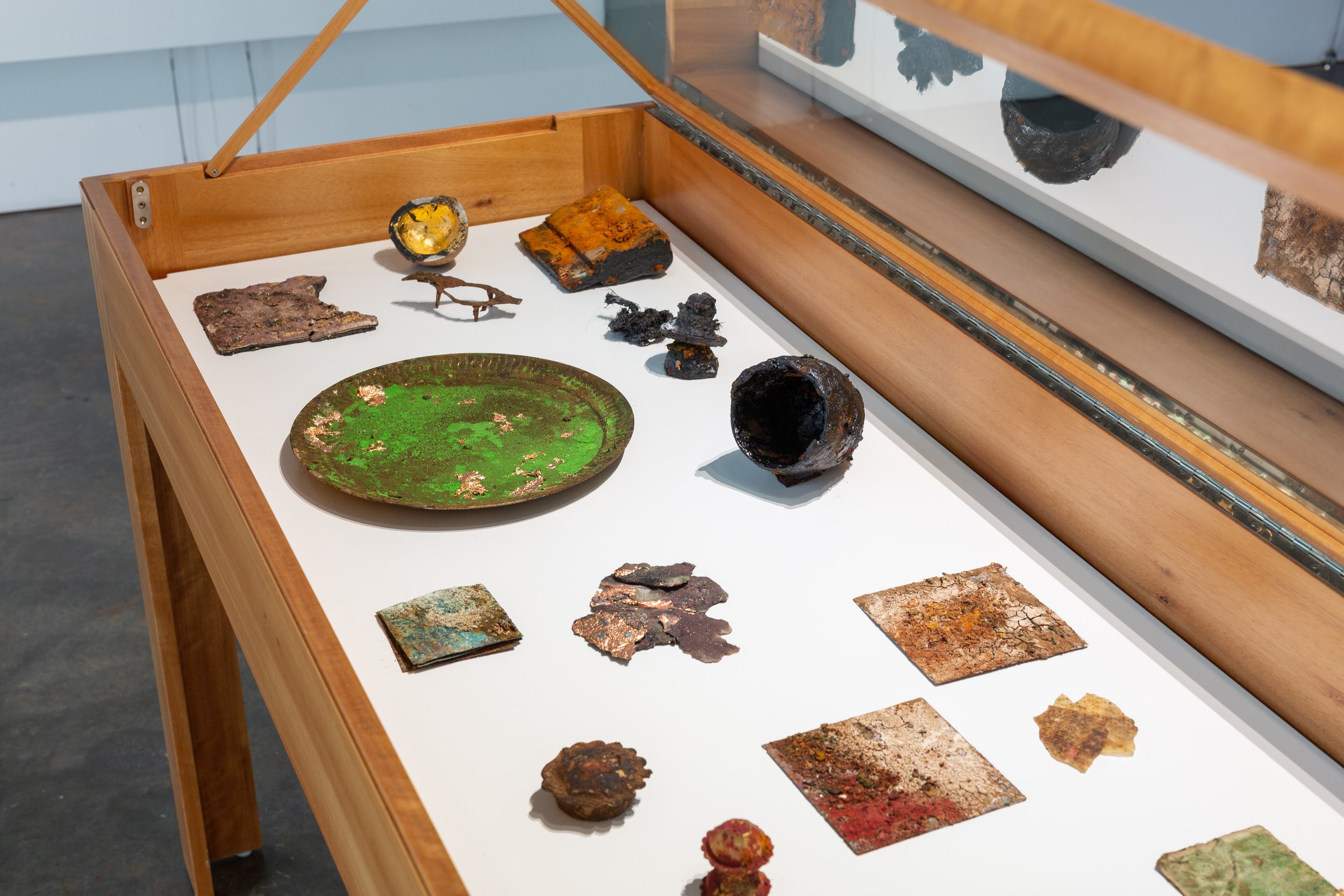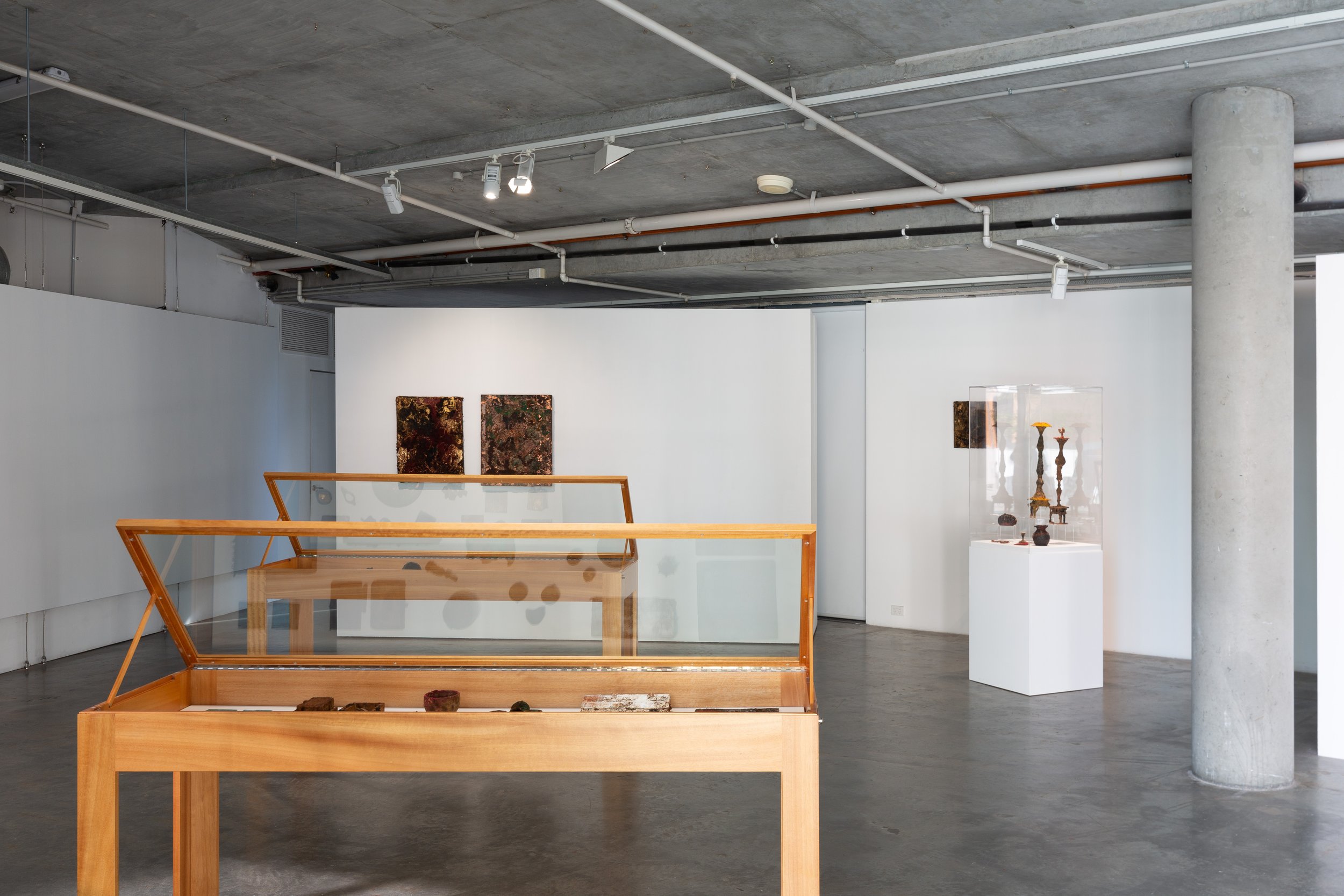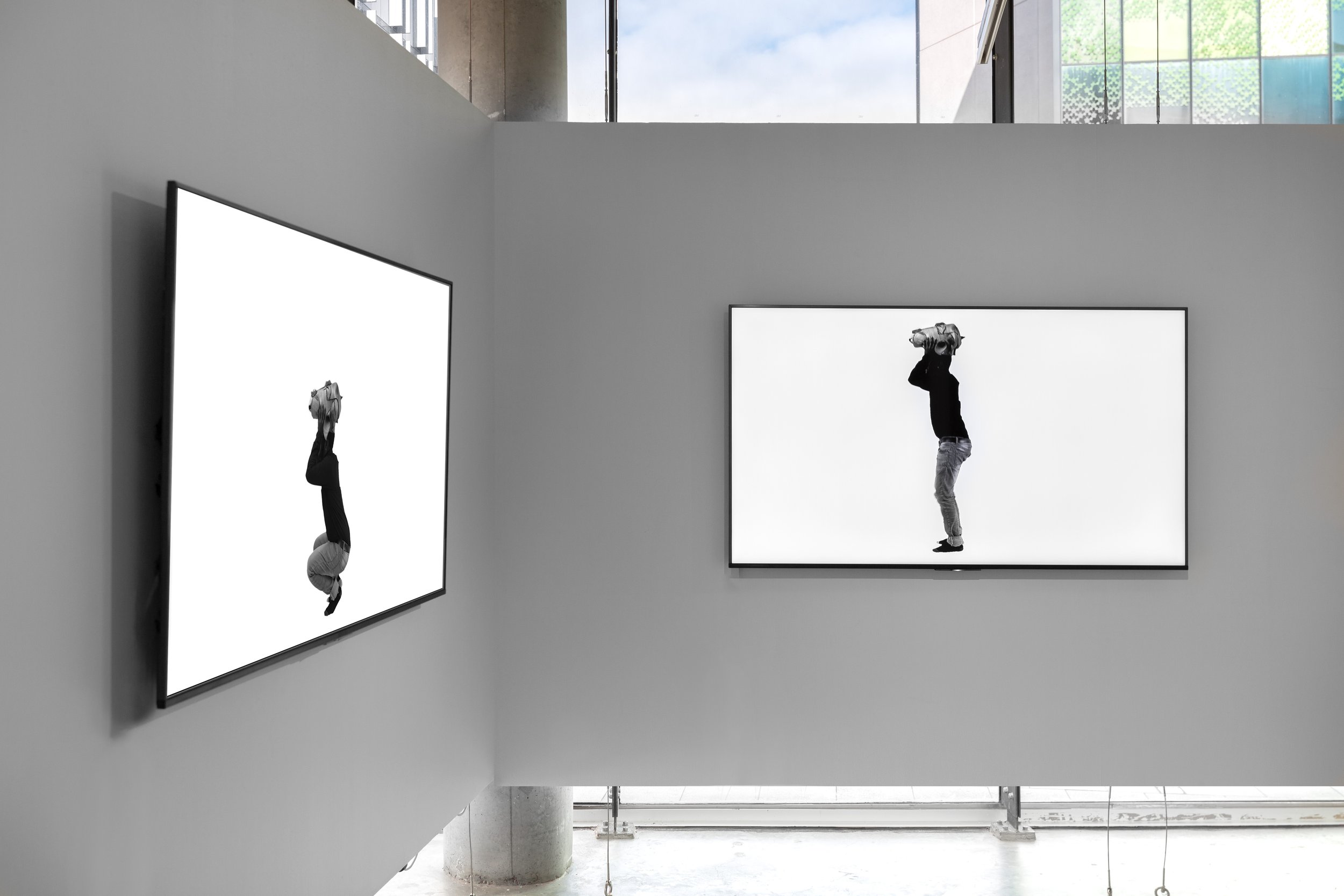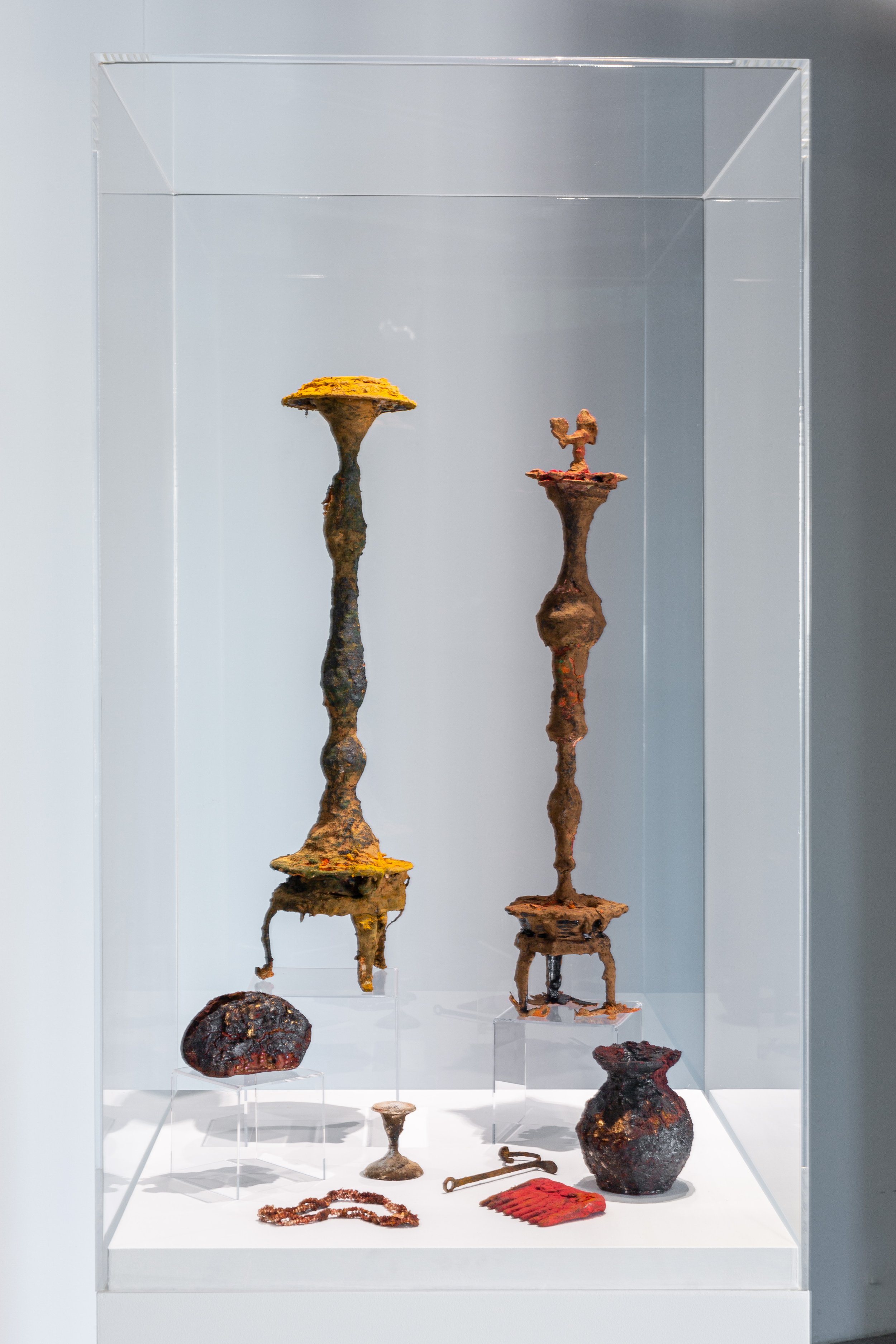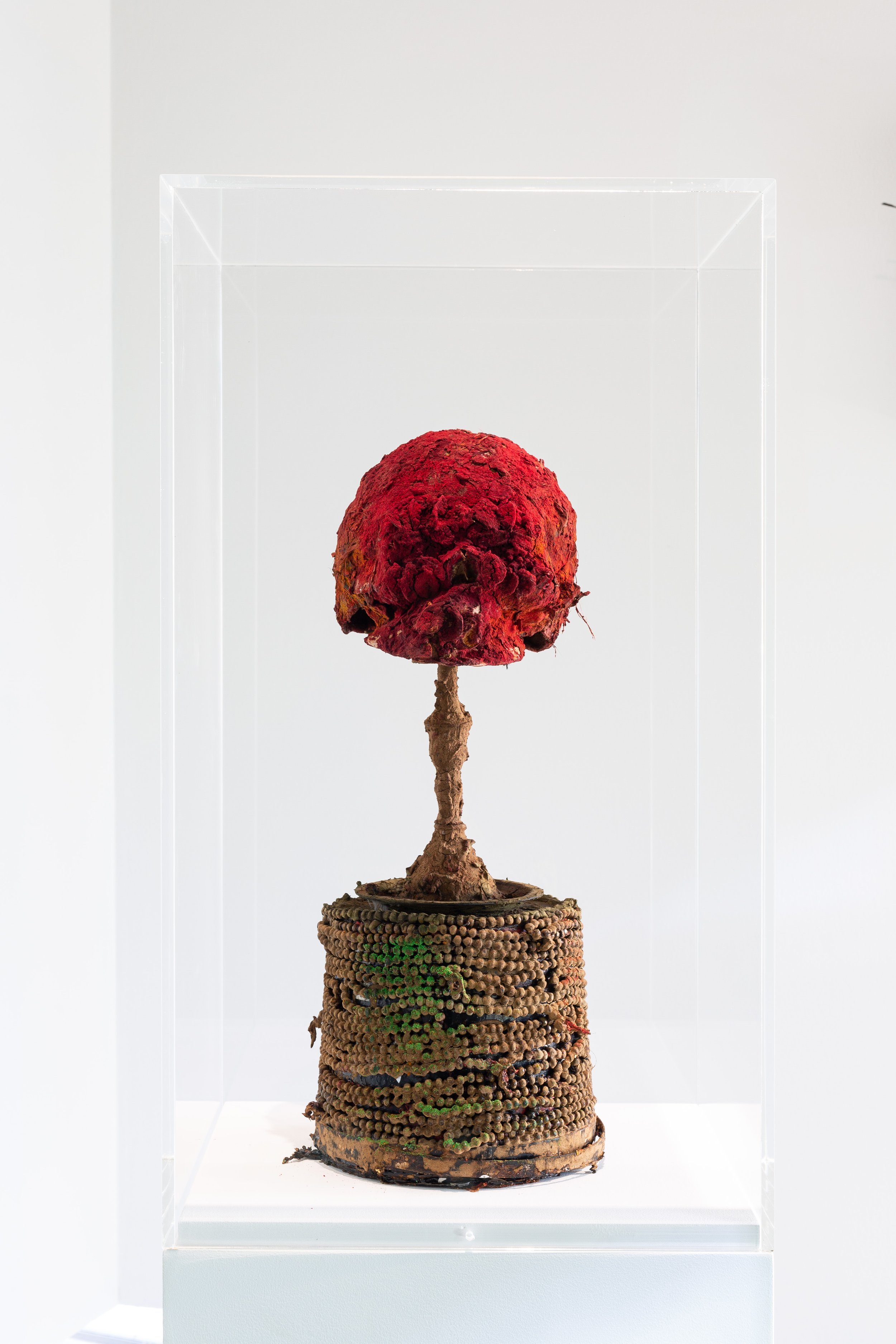KIRTIKA KAIN & SAJAN MANI
’EARTH 200 CE’
31 MARCH - 29 APRIL, 2022
Sajan ani, Art Will Never Die But Cow?, 2019, Two-channel video installation, black and white, 5min. 30 sec. photography by Jessica Maurer.
Kirtika Kain, The Solar Line VI (detail), gold paint, sindoor pigment, binder medium, disused silk screen, 59 x 46 cm, 2020, courtesy of Roslyn Oxley9 Gallery; photo: Luis Power.
ARTIST STATEMENT
Two artists, one shared history. Showcasing a six-month collaboration between Berlin-based artist Sajan Mani and Sydney-based artist Kirtika Kain, Earth 200 CE presents their shared experience of being Dalit, through vastly different mediums. Mani’s intersectional practice utilises durational performance, video and painting to explore the marginalised body, and its relationship to migration, colonial history and ecology. Kain’s materially rich practice foregrounds screen printing and sculpture to envisage artefacts from an ancient Dalit material culture. Both artists work from archives to embolden a contemporary Dalit voice, reimagining and celebrating a history that has been derided and cloaked in invisibility, stigma and subjugation.
Kirtika Kain and Sajan Mani, Earth 200 CE, 2022, installation view, dimensions variable. Photography by Jessica Maurer.
Earth 200 CE
An archive is usually associated with something historic, a placeholder and repository of knowledge, as well as a collection of records of histories and cultures. Through Earth 200 CE, we are given the opportunity to see an archive through a different lens, one that echoes its universal definition of being a record of histories past, but also one that goes beyond this definition as a living and breathing space that continues to create histories and collect memories today. The creation of this living archive binds together the work of artists Kirtika Kain (b.1990) and Sajan Mani (b.1981), whose six-month collaboration has resulted in this show. While Kain and Mani work in different mediums and approach their practices in distinctive ways, Earth 200 CE explores how these two artists from the Dalit diaspora breathe life into collective memory and bring forth intangible histories to concrete ground.
Kirtika Kain and Sajan Mani, Earth 200 CE, 2022, installation view, dimensions variable. Photography by Jessica Maurer.
Kirtika Kain and Sajan Mani, Earth 200 CE, 2022, installation view, dimensions variable. Photography by Jessica Maurer.
The title of the show, Earth 200 CE, recalls a historic time long gone. But as viewers, are we meant to dwell in a past history or induce that history in contemporary times? Kain and Mani weave together a beautiful story that successfully travels in time, not in the futuristic sense associated with time travel, but rather in captures of temporal fluidity. This fluidity makes its presence known in the objects and screen-prints of Kain, and the performance video installation of Mani, as we are presented with snippets of memories drawn from historical and contemporary archives that are simultaneously collective yet personal. The media used by both artists, one using material to create objects and prints (Kain) and the other using his body as material (Mani), also reflects a temporal fluidity where past, present and future are merged within a single space.
Kirtika Kain and Sajan Mani, Earth 200 CE, 2022, installation view, dimensions variable. Photography by Jessica Maurer.
Kain’s oeuvre in this show exhibits a collection of objects and screen-prints. Scattered around the room, the objects and prints talk to one another and respond to each other’s presence. For Earth 200 CE, Kain has been inspired by When I Hid My Caste by Baburao Bagul, a revolutionary Marathi writer of Dalit literature. Bagul’s powerful writing is reflected in Kain’s work as she artfully depicts writing and literature through her own visual language, imagining ‘what sort of objects would fall out’ if Bagul’s book was shaken.
Kirtika Kain and Sajan Mani, Earth 200 CE, 2022, installation view, dimensions variable. Photography by Jessica Maurer.
The objects include etched zinc plates of architectural plans, copper plates, combs, boxes, trinkets, jewellery, funerary objects, vessels, urns, skulls, medical equipment, bridal clothing, remnants of the Earth, and pots and cups. Kain casts these objects as if in prayer, dedicating them to the many different archives and memories she draws her vision from. It is almost as if these objects have been culled out of the earth, speaking to a soil that has been the foundation of earth for centuries, a soil that was present in 200 CE and a soil that is present today, a soil that explores historical imprints and traces. The objects in this exhibition are presented the way they would have been exhibited in a museum; Kain’s intention here is to show that everyday objects inspired by a Dalit past and present, deserve the same veneration and respect that objects in a museum receive, carving a space for a long-deserved yet still unestablished museum space that celebrates the beauty of a Dalit archive.
Kirtika Kain and Sajan Mani, Earth 200 CE, 2022, installation view, dimensions variable. Photography by Jessica Maurer.
Kirtika Kain and Sajan Mani, Earth 200 CE, 2022, installation view, dimensions variable. Photography by Jessica Maurer.
Sajan Mani’s Art will never Die, but COW? is strikingly different from Kain’s work for its performative visuality in a digitised landscape (the performance is displayed on two screens of the walls of the gallery). However, Mani’s work pairs in a beautiful manner with Kain’s, despite the difference of their works’ textures as well as their approach to art practices. Mani’s performance is a rendition of himself holding a cow mask/ head and moving up and down as though doing squats; this is indicative of an Indian person carrying the burden of Brahmanical knowledge production. The clever title of Mani’s work invokes the idea of this knowledge through the symbol of the cow, a venerated animal in India, considered holy and religious especially by upper-castes. The performance by Mani is an embodiment of human-animal relations, where the body of man (Mani) here becomes the body of the cow itself. This interaction of bodies reflects Mani’s ancestral connections, where his Dalit ancestors were made to plough fields in the same way as cows. Through this work, Mani questions the notion of the body itself and its relations to history and the present, once again reflecting a temporal fluidity that comments on socio-political issues.
Kirtika Kain and Sajan Mani, Earth 200 CE, 2022, installation view, dimensions variable. Photography by Jessica Maurer.
Kirtika Kain and Sajan Mani, Earth 200 CE, 2022, installation view, dimensions variable. Photography by Jessica Maurer.
Kirtika Kain and Sajan Mani, Earth 200 CE, 2022, installation view, dimensions variable. Photography by Jessica Maurer.
Kirtika Kain and Sajan Mani, Earth 200 CE, 2022, installation view, dimensions variable. Photography by Jessica Maurer.
Kain and Mani’s different approaches interweave into collective narratives in Earth 200 CE. The parallels to the body in both their practices is undeniable and extremely significant. Kain’s body touches the material and moulds these materials into objects; the materials she uses are an extension of her body, framing a past and present through a connection of body, material and earth in a visceral manner. Mani’s work is the body itself, where his performative installation shapes the body as material as well as a strong comment on society. Through this striking exhibition, Kain and Mani speak to sensibilities of body and material, and also to questions of temporality and fluidity. Earth 200 CE seems to be an archive in the making, exploring Kain and Mani’s shared experiences of being Dalit, reimagining and creating their personal and collective memories and histories, and showcasing a celebration of a history that has too often been derided and proclaimed shameful and violent. A seemingly intangible history brought to life in contemporary times, Earth 200 CE constructs a space that echoes with power and a sacred silence, presenting viewers with narratives long-forgotten and narratives that will now be forever memorialised.
Anisha Palat
PhD candidate in History of Art, University of Edinburgh.
Thank you to our colleagues Luke Parker (Exhibitions and Project Manager, Chau Chak Wing Museum) and Eleanor Zeichner (Assistant Curator, University of Technology Gallery) for their support towards the development of this exhibition.
Kirtika Kain is represented by Roslyn Oxley9 Gallery
Sajan Mani is represented by Nome Gallery
Roomsheet
Exhibition essay by Anisha Palat
Bios
PODCAST
In conversation with Kirtika Kain, Sajan Mani and Anish Palat
Episode 7 of Opening Drinks is a two part conversation in response to Kirtika Kain and Sajan Mani's recent exhibition, Earth 200 CE at Verge in March 2022. The first conversation is between Kirtika and Verge director Tesha Malott that examines Kirtika's curatorial and artistic choices behind her recent exhibition. The second part is a discussion between Kirtika and her collaborator and fellow Dalit artist, Sajan Mani, and Indian writer Anisha Palat.




